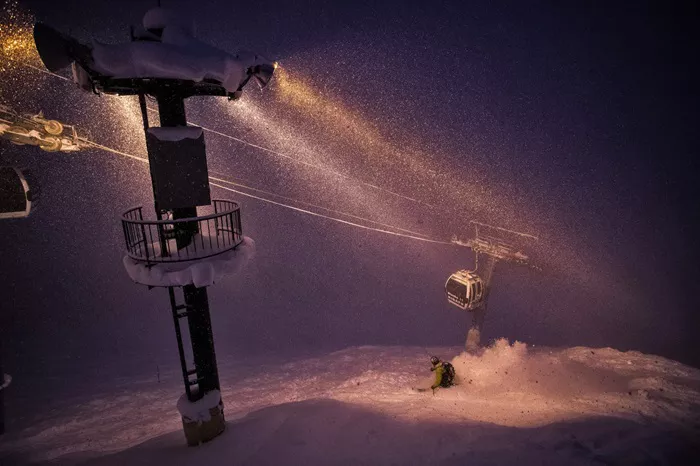When hitting the slopes after dark, the right lens color can significantly impact your performance and safety. Night skiing poses unique challenges, such as reduced visibility and varying light conditions, which makes selecting the appropriate lens color crucial. This guide explores the best lens colors for night skiing, helping you make an informed choice for your next adventure.
Understanding Night Skiing Conditions
Night skiing brings a different set of challenges compared to daytime skiing. The primary issue is the reduced light, which affects how well you can see the terrain and obstacles. Additionally, artificial lighting on the slopes can create harsh contrasts and reflections. Understanding these conditions is essential to selecting the right lens color.
Night skiing often involves skiing under artificial lights, which can vary in intensity and color temperature. This creates a need for lenses that enhance contrast and reduce glare while maintaining clarity. The right lens color can help you navigate these conditions more effectively, ensuring a safer and more enjoyable experience.
Key Factors in Choosing Night Skiing Lenses
Light Transmission
Lenses with higher light transmission are preferable for night skiing because they allow more light to reach your eyes. This helps in low-light conditions, improving visibility. Lenses with a high Visible Light Transmission (VLT) percentage are ideal as they maximize the amount of light that passes through.
Contrast Enhancement
At night, distinguishing between different features on the slope becomes crucial. Lenses that enhance contrast can help you differentiate between shadows and illuminated areas, making it easier to navigate the terrain. Contrast-enhancing lenses improve depth perception and clarity, which are vital for safe skiing in low-light conditions.
Glare Reduction
Glare from artificial lights can be a significant issue during night skiing. Lenses that reduce glare help to minimize the harsh reflections and light spots that can distract and impair vision. This feature is essential for maintaining clear vision and avoiding potential hazards on the slope.
Best Lens Colors for Night Skiing
Yellow Lenses
Yellow lenses are highly recommended for night skiing due to their ability to enhance contrast and depth perception. They work by filtering out blue light, which can cause glare and reduce visibility. Yellow lenses also improve overall brightness, making them ideal for low-light conditions. They are particularly effective under artificial lights, which is why many night skiers prefer them.
see also: How To Choose Sunglasses For Skiing?
Clear Lenses
Clear lenses are another excellent choice for night skiing. They offer 100% VLT, meaning they allow the maximum amount of light to pass through. Clear lenses are perfect for extremely dark conditions or when no light is available. They do not alter the colors or contrast but ensure optimal visibility in the darkest environments.
Amber Lenses
Amber lenses are also suitable for night skiing. They offer a moderate VLT and enhance contrast by filtering out blue light. Amber lenses can improve depth perception and reduce glare, making them a good option for skiing under various lighting conditions. They provide a balance between brightness and contrast, making them versatile for night skiing.
Rose Lenses
Rose lenses can be a good option for night skiing in certain conditions. They enhance contrast and depth perception while providing a slight boost in brightness. Rose lenses are particularly effective when skiing under artificial lighting that may have a warmer tone. They can help in differentiating between shadows and lit areas, improving overall visibility.
Considerations When Choosing Night Skiing Lenses
Personal Preference
Personal preference plays a significant role in choosing the right lens color. Some skiers may prefer the brightness and clarity provided by clear lenses, while others might opt for the contrast-enhancing features of yellow or amber lenses. It’s important to try different lens colors to determine which one works best for you.
Weather Conditions
Weather conditions can affect the performance of different lens colors. For instance, if the night is particularly cloudy or foggy, lenses with enhanced contrast may provide better visibility. On clear nights, clear lenses may be sufficient. Always consider the specific weather conditions when selecting your lenses.
Compatibility with Goggles
Ensure that the lens color you choose is compatible with your goggles. Some lenses may fit better with certain goggle frames, affecting their overall performance. Check the compatibility of the lens with your goggle frame to ensure a comfortable and secure fit.
Summary
Selecting the best lens color for night skiing involves understanding the unique challenges of night skiing conditions and choosing lenses that enhance visibility, contrast, and reduce glare. Yellow lenses are highly recommended for their contrast enhancement and ability to filter blue light. Clear lenses offer maximum light transmission and are ideal for very dark conditions. Amber and rose lenses provide a balance between brightness and contrast, making them suitable for various lighting conditions. Personal preference, weather conditions, and goggle compatibility should also be considered when making your choice.
FAQs:
Can clear lenses be used for night skiing?
Yes, clear lenses are suitable for night skiing as they provide 100% light transmission, making them ideal for extremely dark conditions.
Are amber lenses good for night skiing?
Amber lenses can be good for night skiing as they offer a balance between contrast enhancement and brightness. They help reduce glare and improve visibility in various lighting conditions.
Do rose lenses work well for night skiing?
Rose lenses can be effective for night skiing, especially under artificial lighting. They enhance contrast and depth perception while providing a slight boost in brightness.
How do I choose the right lens color for night skiing?
Consider factors such as light transmission, contrast enhancement, glare reduction, and personal preference when choosing the right lens color. Testing different lenses in varying conditions can help you find the best option for your needs.
related topics:
- How A Corporate Duopoly Ruined Skiing?
- Why Is Skiing So Expensive?
- Why Do Your Calves Hurt After Skiing?

